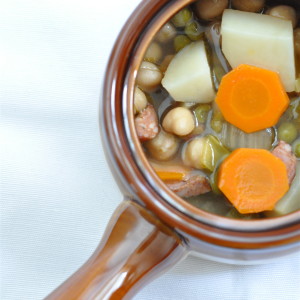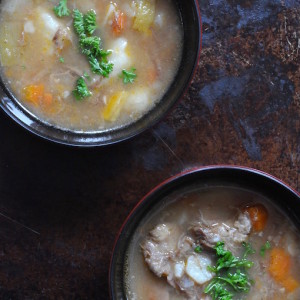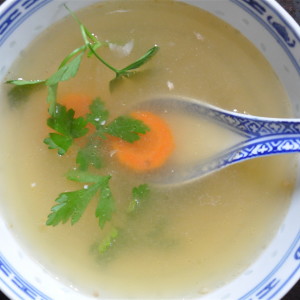Queen Henrietta Maria’s Morning Broth
Long before Pop Tarts or Kellogg’s Rice Krispies were widely available, people breakfasted differently.

Then as now, what you ate depended on your societal status. If you were a Tudor monarch, you ate very well indeed.

If you haven’t heard of Queen Henrietta Maria, a quick history lesson. Born in 1609, she married England’s Charles I in 1625. Marriage made her Queen of England, Scotland, and Ireland. Her rule ended in 1649, when Charles I was executed.

During the Tudor era niceties like potable water and working sanitation systems weren’t commonplace. As coffee and tea would not arrive on English shores for another decade, people drank light ales with their meals. If they were royalty, that meal might be a broth, like Henrietta Maria’s.
Much of the above information comes from Colin Spencer’s fascinating British Food: An Extraordinary Thousand Years of History.

The recipe for Henrietta Maria’s Morning Broth comes from The Closet of Sir Kenelm Digby, published in 1669. Spencer doesn’t print the recipe, but he does list the ingredients: lean veal, beef, mutton, a hen, onion, garlic, parsley, thyme, mint, coriander, saffron, pepper, salt, and a clove. This was cooked, then poured over toast. Once the toast was fully absorbed, cabbage, parsley root, leeks, and endives might be added to the broth. During the summer months, additional vegetables joined the party.

As fair amounts of broth are consumed Chez IK, I decided to give Henrietta Maria’s Morning Broth a go. While it wasn’t dirt cheap, neither was it bankrupting. The lamb shank, which stood in for mutton, cost $8.

The beef bones cost $5.

The veal bones and “gunge”–that is, their cooking juices–were saved from another meal. Veal is an occasion in our house, eaten perhaps once yearly, and I would never waste a morsel.

As for chicken bones, I think I’ve mentioned my habit of stuffing the freezer with chicken bones until nothing else fits, making a gigantic pot of broth, then pressure canning the lot.

The remaining ingredients are items I usually keep in the house, save parsley root.

Before diving into the recipe, some words about skimming and straining. Normally I don’t skim my broths, because 1. I loathe skimming, and 2. I strain broths as part of the canning process, and finally 3. a bit of gunk at the bottom of jar doesn’t bother me.
But this time out I screwed up, blithely tossing a bunch of parsley into the pot without stopping to notice how sandy it was. Atop this, I’d asked the butcher to saw the lamb shank in three, so marrow was clouding the broth.

Did I have cheesecloth in the house? Of course not.

No cheesecloth. The view out the window, with filter.
I considered. My coffeemaker uses a small, flimsy filter. I tried using one. It immediately split. Attractive visual below.

Then I remembered Nigella Lawson putting rosemary into a nylon stocking while making Pasta E Fagioli. After some hunting, I located the recipe in Nigella Bites.
I had to scissor the top layer of nylon, as the broth was pooling rather than passing through the fabric. That probably doesn’t make much sense, but the point is, it worked. The nylon eventually became overly saturated, requiring replacing, but eventually I was left with a lovely, limpid broth. (And a sink full of sandy grit.)

My advice? Rinse your vegetables thoroughly. If the worst happens, strain through a nylon. Or try to keep cheesecloth in the house.

Picture from a time I had cheesecloth in the house.
Served in small portions, Queen Henrietta Maria’s Morning Broth would make a lovely first course for a holiday meal, or nice light lunch. Sip it alone, or add a few cooked vegetables, diced small, or a handful of tiny cooked pasta.

Queen Henrietta Maria’s Morning Broth
Adapted from British Food: An Extraordinary Thousand Years of History by Colin Spencer
Please see notes for a discussion of ingredient amount and cooking times.
Approximately 5 pounds/2 1/4 kilos mixed beef, lamb, veal, and chicken bones, yielded 9 cups/2.2 liters broth
Cooking time: 4-12 hours on a conventional stove.
Queen Henrietta Maria’s Morning Broth may be prepared using a pressure cooker, Instant Pot, or slow cooker. Follow your appliance’s instructions.
A mixture of beef, chicken, lamb, and veal bones: I used:
1/2 pound/227 grams veal bones
1.5 pounds/680 grams lamb shank, sliced in thirds
2.5 pounds /1 kilo beef bones
1.5 pounds/680 grams mixed chicken bones
1 onion, peeled and sliced
3 garlic cloves, peeled and sliced
1 bunch parsley (3 oz/90g)
a few sprigs thyme
1/4 teaspoon coriander seed
2 strands saffron
1 teaspoon black peppercorns
a generous handful salt (yes, I salt my broths)
3 parsley roots, trimmed (optional, as they can be hard to find) and cut into coins
1 leek, well washed and cut into coins
2 carrots, peeled and sliced into coins
1 bay leaf
The most important part of making this broth is cleaning the vegetables. Make sure the leek and parsley are free of grit.
If your carrots and parsley roots aren’t organic, peel them.
Put all ingredients in a pot that holds everything comfortably and cover with water. You want ingredients just covered, not swamped.
Bring to gentle simmer. Do not allow broth to boil.
Skim for first 20 minutes or so. If, like me, you encounter gritty soup, you can fix this at the end of cooking.
Allow broth to simmer gently, 4-12 hours.
To strain:
If your broth is nicely straw colored, spoon it through a colander into a deep bowl. Allow it to cool but don’t leave it out on the counter more than 1 hour. Broth ferments rapidly. Cover and refrigerate it up to three days. To keep broth refrigerated, reboil every third day.
Broth may be frozen up to three months.
Broth may be pressure canned for 20 minutes, 11psi at sea level. (which is what I did).
Serve Henrietta Maria’s Morning Broth in small cups by itself, with a diced vegetable garnish, or small diced pasta. It would also make a lovely first course or excellent base for holiday gravy.
Notes:
As discussed in the post, I regularly freeze leftover bones and cooking juices for making broths. I never measure amounts when doing so, but did this time to create the recipe.
Quantities are up to you. Do make sure you have a reasonably equal mixture of lamb, chicken, and beef. These can be bony, cheap cuts.
If you eat veal, even the smallest amount adds tremendous flavor to the broth.
You can make more or less broth according to your needs, the size of your pot, and the amount of storage space available.
Meat broths benefit from long cooking times–Julia Child, in Mastering The Art of French Cooking, says 4-5 hours. Ann Willan, in The Observer French Cookery School, says a veal broth should cook 10-12 hours. Barbara Kafka, in Soup, A Way of Life, says beef broth should cook 8 hours. Ultimately, the decision is yours. But the longer you can cook your broth, the better it will be.
Readers will note I did not brown my beef bones. If you wish to, the traditional procedure is to preheat the oven to 450F/230C and brown the beef bones well, turning then frequently, before adding them to the broth.

Henrietta Maria’s Morning Broth, pressure canned.
—
The food world lost two pioneering writers this week. Gael Greene was writing about food at New York Magazine long before food writing was deeply respected or understood. Greene later co-found New York City’s CityMeals on Wheels with James Beard. Greene was 88.
Julie Powell requires no introduction. She was only 49. The outpouring of grief meeting her passing is fitting if heatbreaking tribute to this intrepid, witty writter and blogger who is gone far too soon.





